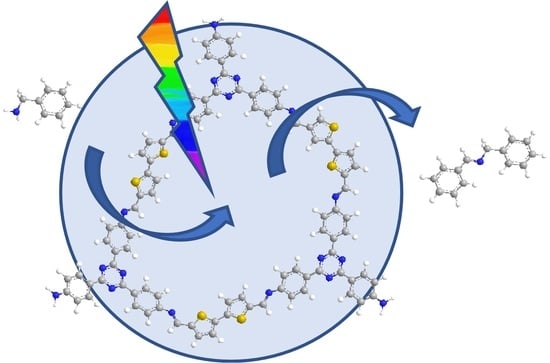Thiophene-Based Covalent Triazine Frameworks as Visible-Light-Driven Heterogeneous Photocatalysts for the Oxidative Coupling of Amines
Abstract
:1. Introduction
2. Results and Discussion
2.1. Synthesis and Characterization
2.2. Photocatalytic Coupling of Amines
3. Experimental Section
3.1. Reagents and Chemicals
3.2. Synthesis of TP-CTF
3.3. Catalyst Characterization
3.4. Photocatalytic Experiments
3.4.1. General Procedure for the Homo-Coupling of Benzylamine
3.4.2. General Procedure for the Cross-Coupling of Amines
4. Conclusions
Supplementary Materials
Author Contributions
Funding
Institutional Review Board Statement
Informed Consent Statement
Data Availability Statement
Conflicts of Interest
References
- Krishnaraj, C.; Jena, H.S.; Leus, K.; Van Der Voort, P. Covalent triazine frameworks-a sustainable perspective. Green Chem. 2020, 22, 1038–1071. [Google Scholar] [CrossRef]
- Ma, S.; Li, Z.; Jia, J.; Zhang, Z.; Xia, H.; Li, H.; Chen, X.; Xu, Y.; Liu, X. Amide-linked covalent organic frameworks as efficient heterogeneous photocatalysts in water. Chin. J. Catal. 2021, 42, 2010–2019. [Google Scholar] [CrossRef]
- Hao, Q.; Tao, Y.; Ding, X.; Yang, Y.; Feng, J.; Wang, R.-L.; Chen, X.-M.; Chen, G.-L.; Li, X.; OuYang, H.; et al. Porous organic polymers: A progress report in China. Sci. China Chem. 2023, 66, 620–682. [Google Scholar] [CrossRef]
- Chongdar, S.; Bhattacharjee, S.; Bhanja, P.; Bhaumik, A. Porous organic–inorganic hybrid materials for catalysis, energy and environmental applications. Chem. Commun. 2022, 58, 3429–3460. [Google Scholar] [CrossRef] [PubMed]
- Mukherjee, G.; Thote, J.; Aiyappa, H.B.; Kandambeth, S.; Banerjee, S.; Vanka, K.; Banerjee, R. A porous porphyrin organic polymer (PPOP) for visible light triggered hydrogen production. Chem. Commun. 2017, 53, 4461–4464. [Google Scholar] [CrossRef] [PubMed]
- Zhang, T.; Xing, G.; Chen, W.; Chen, L. Porous organic polymers: A promising platform for efficient photocatalysis. Mater. Chem. Front. 2020, 4, 332–353. [Google Scholar] [CrossRef]
- Ji, G.; Zhao, Y.; Liu, Z. Green Chemical Engineering Design of porous organic polymer catalysts for transformation of carbon dioxide. Green Chem. Eng. 2022, 3, 96–110. [Google Scholar] [CrossRef]
- Chen, M.; Zhang, J.; Liu, C.; Li, H.; Yang, H.; Feng, Y.; Zhang, B. Construction of Pyridine-Based Chiral Ionic Covalent Organic Frameworks as a Heterogeneous Catalyst for Promoting Asymmetric Henry Reactions. Org. Lett. 2021, 23, 1748–1752. [Google Scholar] [CrossRef]
- Guo, J.; Jiang, D. Covalent Organic Frameworks for Heterogeneous Catalysis: Principle, Current Status, and Challenges. ACS Cent. Sci. 2020, 6, 869–879. [Google Scholar] [CrossRef]
- Zhang, J.; Cao, Y.; Liu, W.; Cao, T.; Qian, J.; Wang, J.; Yao, X.; Iqbal, A.; Qin, W. Structural Engineering of Covalent Organic Frameworks Comprising Two Electron Acceptors Improves Photocatalytic Performance. ChemSusChem 2022, 15, e202101510. [Google Scholar] [CrossRef]
- Li, Z.; Zhi, Y.; Shao, P.; Xia, H.; Li, G.; Femg, X.; Chen, X.; Shi, Z.; Liu, X. Covalent organic framework as an efficient, metal-free, heterogeneous photocatalyst for organic transformations under visible light. Appl. Catal. B 2019, 245, 334–342. [Google Scholar] [CrossRef]
- Li, Z.; Wang, J.; Ma, S.; Zhang, Z.; Zhi, Y.; Zhang, F.; Xia, H.; Henkelman, G.; Liu, X. 2D covalent organic frameworks for photosynthesis of α-trifluoromethylated ketones from aromatic alkenes. Appl. Catal. B 2022, 310, 121335. [Google Scholar] [CrossRef]
- Yang, Y.; Niu, H.; Xu, L.; Zhang, H.; Cai, Y. Triazine functionalized fully conjugated covalent organic framework for efficient photocatalysis. Appl. Catal. B 2020, 269, 118799. [Google Scholar] [CrossRef]
- Saputra, E.; Nugraha, M.W.; Prawiranegara, B.A.; Sambudi, N.S.; Oh, W.; Peng, W.; Sugesti, H.; Utama, P.S. Synergistic copper-modified covalent triazine framework for visible-light-driven photocatalytic degradation of organic pollutant. Environ. Nanotechnol. Monit. Manag. 2023, 19, 100774. [Google Scholar] [CrossRef]
- Qian, Z.; Wang, Z.J.; Zhang, K.A.I. Covalent Triazine Frameworks as Emerging Heterogeneous Photocatalysts. Chem. Mater. 2021, 33, 1909–1926. [Google Scholar] [CrossRef]
- Liu, M.; Guo, L.; Jin, S.; Tan, B. Covalent triazine frameworks: Synthesis and applications. J. Mater. Chem. A Mater. 2019, 7, 5153–5172. [Google Scholar] [CrossRef]
- Bügel, S.; Hoang, Q.-D.; Spieß, A.; Sun, Y.; Xing, S.; Janiak, C. Biphenyl-Based Covalent Triazine Framework/Matrimid ® Mixed-Matrix Membranes for CO2/CH4 Separation. Membranes 2021, 11, 795. [Google Scholar] [CrossRef] [PubMed]
- Dey, S.; Bügel, S.; Sorribas, S.; Nuhnen, A. Synthesis and Characterization of Covalent Triazine Framework CTF-1 @ Polysulfone Mixed Matrix Membranes and Their Gas Separation Studies. Front. Chem. 2019, 7, 693. [Google Scholar] [CrossRef]
- Bhadra, M.; Kandambeth, S.; Sahoo, M.K.; Addicoat, M.; Balaraman, E.; Banerjee, R. Triazine Functionalized Porous Covalent Organic Framework for Photo-organocatalytic E- Z Isomerization of Olefins. J. Am. Chem. Soc. 2019, 141, 6152–6156. [Google Scholar] [CrossRef]
- Sun, R.; Tan, B. Covalent Triazine Frameworks(CTFs) for Photocatalytic Applications. Chem. Res. Chin. Univ. 2022, 38, 310–324. [Google Scholar] [CrossRef]
- Abednatanzi, S.; Derakhshandeh, P.G.; Dalapati, S.; Veerapandian, S.K.P.; Froissart, A.C.; Epping, J.D.; Morent, R.; De Geyter, N.; Van Der Voort, P. Metal-Free Chemoselective Reduction of Nitroarenes Catalyzed by Covalent Triazine Frameworks: The Role of Embedded Heteroatoms. ACS Appl. Mater. Interfaces 2022, 14, 15287–15297. [Google Scholar] [CrossRef] [PubMed]
- Yang, Q.; Luo, M.; Liu, K.; Cao, H.; Yan, H. Covalent organic frameworks for photocatalytic applications. Appl. Catal. B 2020, 276, 119174. [Google Scholar] [CrossRef]
- Caballero, R.; Cohen, B.; Gutiérrez, M. Thiophene-based covalent organic frameworks: Synthesis, photophysics and light-driven applications. Molecules 2021, 26, 7666. [Google Scholar] [CrossRef] [PubMed]
- Liu, M.; Yao, C.; Liu, C.; Xu, Y. Thiophene-based porous organic networks for volatile iodine capture and effectively detection of mercury ion. Sci. Rep. 2018, 8, 14071. [Google Scholar] [CrossRef]
- An, W.K.; Zhen, S.J.; Du, Y.N.; Ding, S.Y.; Li, Z.J.; Jiang, S.; Qin, Y.; Liu, X.; Wei, P.F.; Cao, Z.Q.; et al. Thiophene-embedded conjugated microporous polymers for photocatalysis. Catal. Sci. Technol. 2020, 10, 5171–5180. [Google Scholar] [CrossRef]
- Meng, L.; Fujikawa, T.; Kuwayama, M.; Segawa, Y.; Itami, K. Thiophene-Fused π-Systems from Diarylacetylenes and Elemental Sulfur. J. Am. Chem. Soc. 2016, 138, 10351–10355. [Google Scholar] [CrossRef]
- Cui, Y.; Du, J.; Liu, Y.; Yu, Y.; Wang, S.; Pang, H.; Liang, Z.; Yu, J. Design and synthesis of a multifunctional porous N-rich polymer containing s-triazine and Tröger’s base for CO2 adsorption, catalysis and sensing. Polym. Chem. 2018, 9, 2643–2649. [Google Scholar] [CrossRef]
- López-Magano, A.; Jiménez-Almarza, A.; Alemán, J.; Mas-Ballesté, R. Metal–Organic Frameworks (MOFs) and Covalent Organic Frameworks (COFs) Applied to Photocatalytic Organic Transformations. Catalysts 2020, 10, 720. [Google Scholar] [CrossRef]
- Sönmez, T.; Belthle, K.S.; Iemhoff, A.; Uecker, J.; Artz, J.; Bisswanger, T.; Stampfer, C.; Hamzah, H.H.; Nicolae, S.A.; Titirici, M.M.; et al. Metal free-covalent triazine frameworks as oxygen reduction reaction catalysts—Structure-electrochemical activity relationship. Catal. Sci. Technol. 2021, 11, 6191–6204. [Google Scholar] [CrossRef]
- Puthiaraj, P.; Lee, Y.R.; Zhang, S.; Ahn, W.S. Triazine-based covalent organic polymers: Design, synthesis and applications in heterogeneous catalysis. J. Mater. Chem. A Mater. 2016, 4, 16288–16311. [Google Scholar] [CrossRef]
- Tahir, N.; Krishnaraj, C.; Leus, K.; Van Der Voort, P. Development of covalent triazine frameworks as heterogeneous catalytic supports. Polymers 2019, 11, 1326. [Google Scholar] [CrossRef] [PubMed]
- Yadav, D.; Awasthi, S.K. An unsymmetrical covalent organic polymer for catalytic amide synthesis. Dalton Trans. 2020, 49, 179–186. [Google Scholar] [CrossRef] [PubMed]
- Zhi, Y.; Li, Z.; Feng, X.; Xia, H.; Zhang, Y.; Shi, Z.; Mu, Y.; Liu, X. Covalent organic frameworks as metal-free heterogeneous photocatalysts for organic transformations. J. Mater. Chem. A 2017, 5, 22933–22938. [Google Scholar] [CrossRef]
- Ahmed, I.; Yu, K.; Puthiaraj, P.; Ahn, W.S. Metal-free oxidative desulfurization over a microporous triazine polymer catalyst under ambient conditions. Fuel Process. Technol. 2020, 207, 106469. [Google Scholar] [CrossRef]
- Fuerte-Díez, B.; Valverde-González, A.; Pintado-Sierra, M.; Díaz, U.; Sánchex, F.; Maya, E.M.; Iglesias, M. Phenyl Extended Naphthalene-Based Covalent Triazine Frameworks as Versatile Metal-Free Heterogeneous Photocatalysts. Solar RRL 2022, 6, 1–10. [Google Scholar] [CrossRef]
- Abednatanzi, S.; Derakhshandeh, P.G.; Leus, K.; Callens, F.; Schmidt, J.; Savateev, A.; Van Der Voort, P. Metal-free activation of molecular oxygen by covalent triazine frameworks for selective aerobic oxidation. Sci. Adv. 2020, 6, eaaz2310. [Google Scholar] [CrossRef] [PubMed]
- Jiménez-Almarza, A.; López-Magano, A.; Marzo, L.; Cabrera, S.; Mas-Ballesté, R.; Alemán, J. Imine-Based Covalent Organic Frameworks as Photocatalysts for Metal Free Oxidation Processes under Visible Light Conditions. ChemCatChem 2019, 11, 4916–4922. [Google Scholar] [CrossRef]
- Chen, B.; Wang, L.; Dai, W.; Shang, S.; Lv, Y.; Gao, S. Metal-free and solvent-free oxidative coupling of amines to imines with mesoporous carbon from macrocyclic compounds. ACS Catal. 2015, 5, 2788–2794. [Google Scholar] [CrossRef]
- Roeser, J.; Kailasam, K.; Thomas, A. Covalent triazine frameworks as heterogeneous catalysts for the synthesis of cyclic and linear carbonates from carbon dioxide and epoxides. ChemSusChem 2012, 5, 1793–1799. [Google Scholar] [CrossRef]
- Lian, C.; Zhang, C.; Zhao, Y.; Wang, H.; Li, X.; Huang, L. Oxidative coupling of primary amines to imines catalyzed by CoCl2·6H2O. Appl. Organomet. Chem. 2022, 36, 1–10. [Google Scholar] [CrossRef]
- Liu, L.; Zhang, S.; Fu, X.; Yan, C.H. Metal-free aerobic oxidative coupling of amines to imines. Chem. Commun. 2011, 47, 10148–10150. [Google Scholar] [CrossRef] [PubMed]
- Zheng, H.; Shi, S.; Wang, X.; Zhao, L.; Zhu, G.; Liu, M.; Gao, J.; Xu, J. Covalent Triazine Frameworks as Metal Free Catalysts for the Oxidative Coupling of Amines to Imines. ChemistrySelect 2019, 4, 5073–5080. [Google Scholar] [CrossRef]
- Pachfule, P.; Acharjya, A.; Roeser, J.; Sivasankaran, R.P.; Ye, M.-Y.; Brückner, A.; Schmidt, J.; Thomas, A. Donor–acceptor covalent organic frameworks for visible light induced free radical polymerization. Chem. Sci. 2019, 10, 8316–8322. [Google Scholar] [CrossRef] [PubMed]
- Kang, C.; Zhang, Z.; Usadi, A.K.; Calabro, D.C.; Saunders Baugh, L.; Yu, K.; Wang, Y.; Zhao, D. Aggregated Structures of Two-Dimensional Covalent Organic Frameworks. J. Am. Chem. Soc. 2022, 144, 3192–3199. [Google Scholar] [CrossRef]
- Huang, N.; Chen, X.; Krishna, R.; Jiang, D. Two-Dimensional Covalent Organic Frameworks for Carbon Dioxide Capture through Channel-Wall Functionalization. Angew. Chem. Int. Ed. 2015, 54, 2986–2990. [Google Scholar] [CrossRef] [PubMed]
- Jin, E.; Fu, S.; Hanayama, H.; Addicoat, M.A.; Wei, W.; Chen, Q.; Graf, R.; Landfester, K.; Bonn, M.; Zhang, K.A.I.; et al. A Nanographene-Based Two-Dimensional Covalent Organic Framework as a Stable and Efficient Photocatalyst. Angew. Chem. Int. Ed. 2022, 61, e202114059. [Google Scholar] [CrossRef] [PubMed]
- Han, X.H.; Qi, Q.Y.; Zhou, Z.B.; Zhao, X. Designed Synthesis of a Two-Dimensional Covalent Organic Framework with Three-Level Hierarchical Porosity. Chin. J. Chem. 2020, 38, 1676–1680. [Google Scholar] [CrossRef]
- Li, Y.; Ou, Z.; Liang, B.; Yang, J.; Chen, R.; Qi, H.; Kaiser, U.; Hong, W.; Chen, X.; Du, L.; et al. Cellulose nanocrystals as template for improving the crystallinity of two-dimensional covalent organic framework films. Polymers 2021, 13, 1561. [Google Scholar] [CrossRef]
- Peng, Y.; Hu, Z.; Gao, Y.; Yuan, D.; Kang, Z.; Qian, Y.; Yan, N.; Zhao, D. Synthesis of a Sulfonated Two-Dimensional Covalent Organic Framework as an Efficient Solid Acid Catalyst for Biobased Chemical Conversion. ChemSusChem 2015, 8, 3208–3212. [Google Scholar] [CrossRef]
- Wei, H.; Chai, S.; Hu, N.; Yang, Z.; Wei, L.; Wang, L. The microwave-assisted solvothermal synthesis of a crystalline two-dimensional covalent organic framework with high CO2 capacity. Chem. Commun. 2015, 51, 12178–12181. [Google Scholar] [CrossRef]
- Bertrand, G.H.V.; Michaelis, V.K.; Ong, T.C.; Griffin, R.G.; Dincâ, M. Thiophene-based covalent organic frameworks. PNAS 2013, 110, 4923–4928. [Google Scholar] [CrossRef]
- Kuhn, P.; Forget, A.; Su, D.; Thomas, A.; Antonietti, M. From microporous regular frameworks to mesoporous materials with ultrahigh surface area: Dynamic reorganization of porous polymer networks. J. Am. Chem. Soc. 2008, 130, 13333–13337. [Google Scholar] [CrossRef] [PubMed]
- Li, C.; Li, D.; Zhang, W.; Li, H.; Yu, G. Towards High-Performance Resistive Switching Behavior through Embedding a D-A System into 2D Imine-Linked Covalent Organic Frameworks. Angew. Chem. Int. Ed. 2021, 60, 27135–27143. [Google Scholar] [CrossRef] [PubMed]
- Zanatta, A.R. Revisiting the optical bandgap of semiconductors and the proposal of a unified methodology to its determination. Sci. Rep. 2019, 9, 11225. [Google Scholar] [CrossRef]
- Hu, Y.H.; Ruckenstein, E. Applicability of Dubinin-Astakhov equation to CO2 adsorption on single-walled carbon nanotubes. Chem. Phys. Lett. 2006, 425, 306–310. [Google Scholar] [CrossRef]
- Sharma, A.; Malani, A.; Medhekar, N.V.; Babarao, R. CO2 adsorption and separation in covalent organic frameworks with interlayer slipping. CrystEngComm 2017, 19, 6950–6963. [Google Scholar] [CrossRef]
- Vitillo, J.; Presti, D.; Luz, I.; Llabrés i Xamena, F.X.; Bordiga, S. Visible-light driven photocatalytic coupling of benzylamine over titanium-based MIL-125-NH2 metal-organic framework: A mechanistic study. J. Phys. Chem. C 2020, 124, 23707–23715. [Google Scholar] [CrossRef]
- Mohan, A.; Sayah, M.H.; Al Ahmed, A.; Kadri, O.M.E. Triazine based porous organic polymers for reversible capture of iodine and utilization in antibacterial application. Sci. Rep. 2022, 12, 2638. [Google Scholar] [CrossRef] [PubMed]
- Cheng, H.; Wang, T. Covalent Organic Frameworks in Catalytic Organic Synthesis. Adv. Synth.Catal. 2020, 363, 144–193. [Google Scholar] [CrossRef]
- Li, P.; Dong, X.; Zhang, Y.; Lang, X.; Wang, C. An azine-linked 2D porphyrinic covalent organic framework for red light photocatalytic oxidative coupling of amines. Mater. Today Chem. 2022, 25, 100953. [Google Scholar] [CrossRef]
- Hu, X.; Zhan, Z.; Zhang, J.; Hussain, I.; Tan, B. Immobilized covalent triazine frameworks films as effective photocatalysts for hydrogen evolution reaction. Nat. Commun. 2021, 12, 1–9. [Google Scholar] [CrossRef] [PubMed]
- Prakash, K.; Chaudhary, K.; Masram, D.T. Applied Catalysis A, General A new triazine-cored covalent organic polymer for catalytic applications. Appl. Cata.l A Gen. 2020, 593, 117411. [Google Scholar]
- Chan-Thaw, C.E.; Villa, A.; Katekomol, P.; Su, D.; Thomas, A.; Prati, L. Covalent triazine framework as catalytic support for liquid phase reaction. Nano Lett. 2010, 10, 537–541. [Google Scholar] [CrossRef] [PubMed]
- Li, J.; Zhang, L.; Liu, X.; Shang, N.; Gao, S.; Feng, C.; Wang, C.; Wang, Z. Pd nanoparticles supported on a covalent triazine-based framework material: An efficient and highly chemoselective catalyst for the reduction of nitroarenes. New J. Chem. 2018, 42, 9684–9689. [Google Scholar] [CrossRef]
- Sportelli, G.; Boselli, T.; Protti, S.; Serpone, N.; Ravelli, D. Photovoltaic Materials as Heterogeneous Photocatalysts: A Golden Opportunity for Sustainable Organic Syntheses. Solar RRL 2023, 2201008, 1–22. [Google Scholar]
- Yang, L.; Wang, J.; Zhao, K.; Fang, Z.; Qiao, H.; Zhai, L.; Mi, L. Photoactive Covalent Organic Frameworks for Catalyzing Organic Reactions. ChemPlusChem 2022, 87, e202200281. [Google Scholar] [CrossRef]
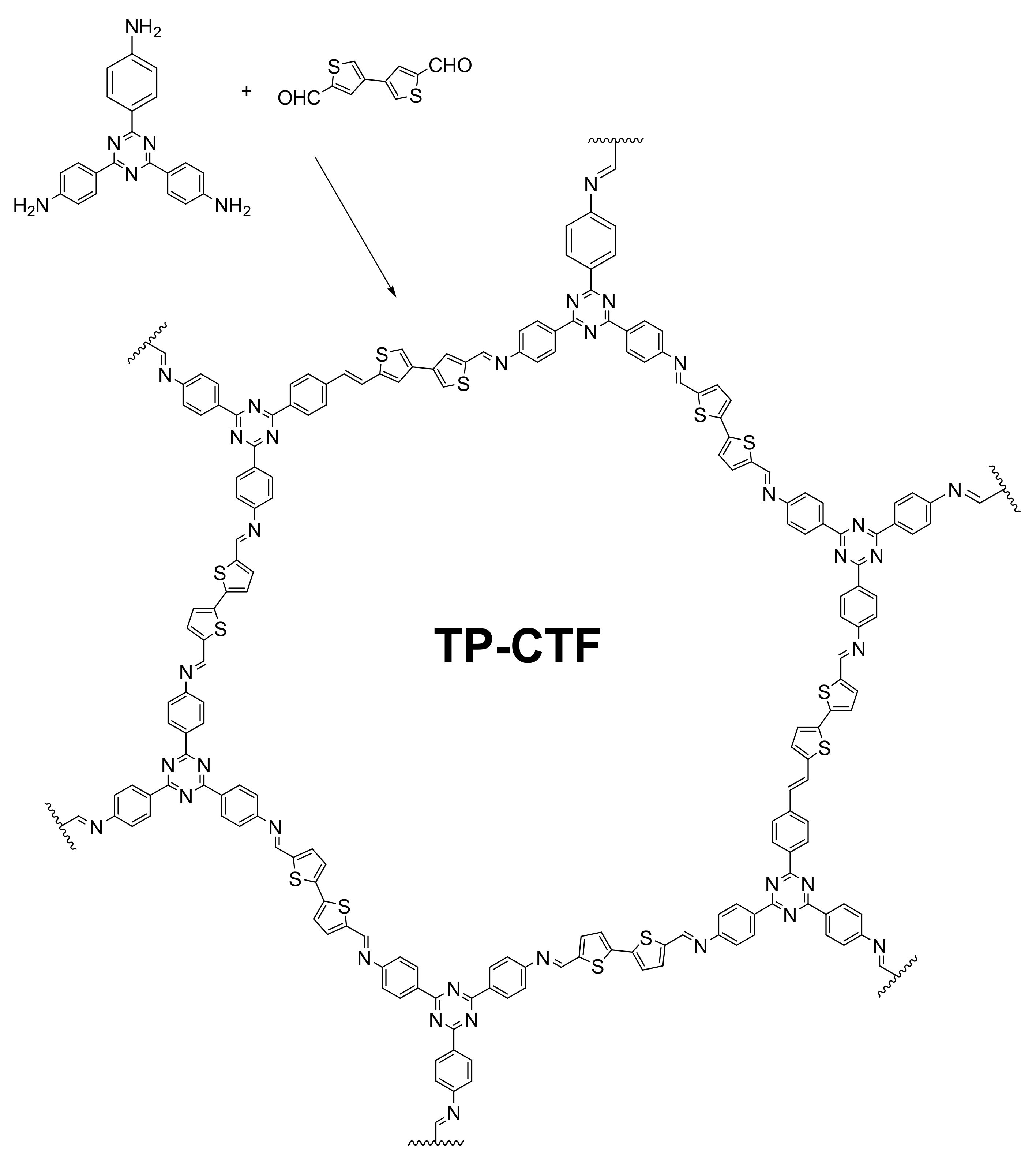
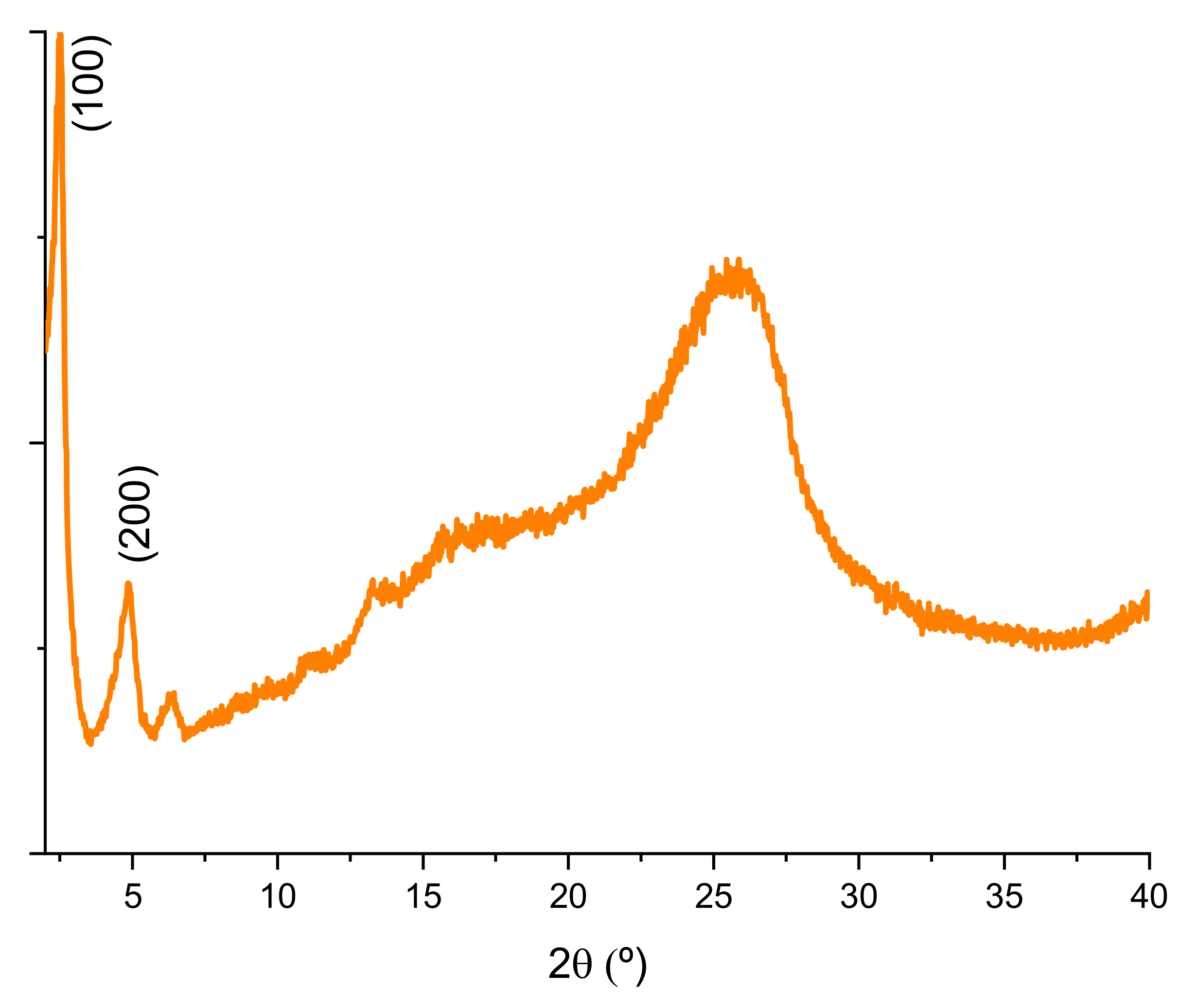


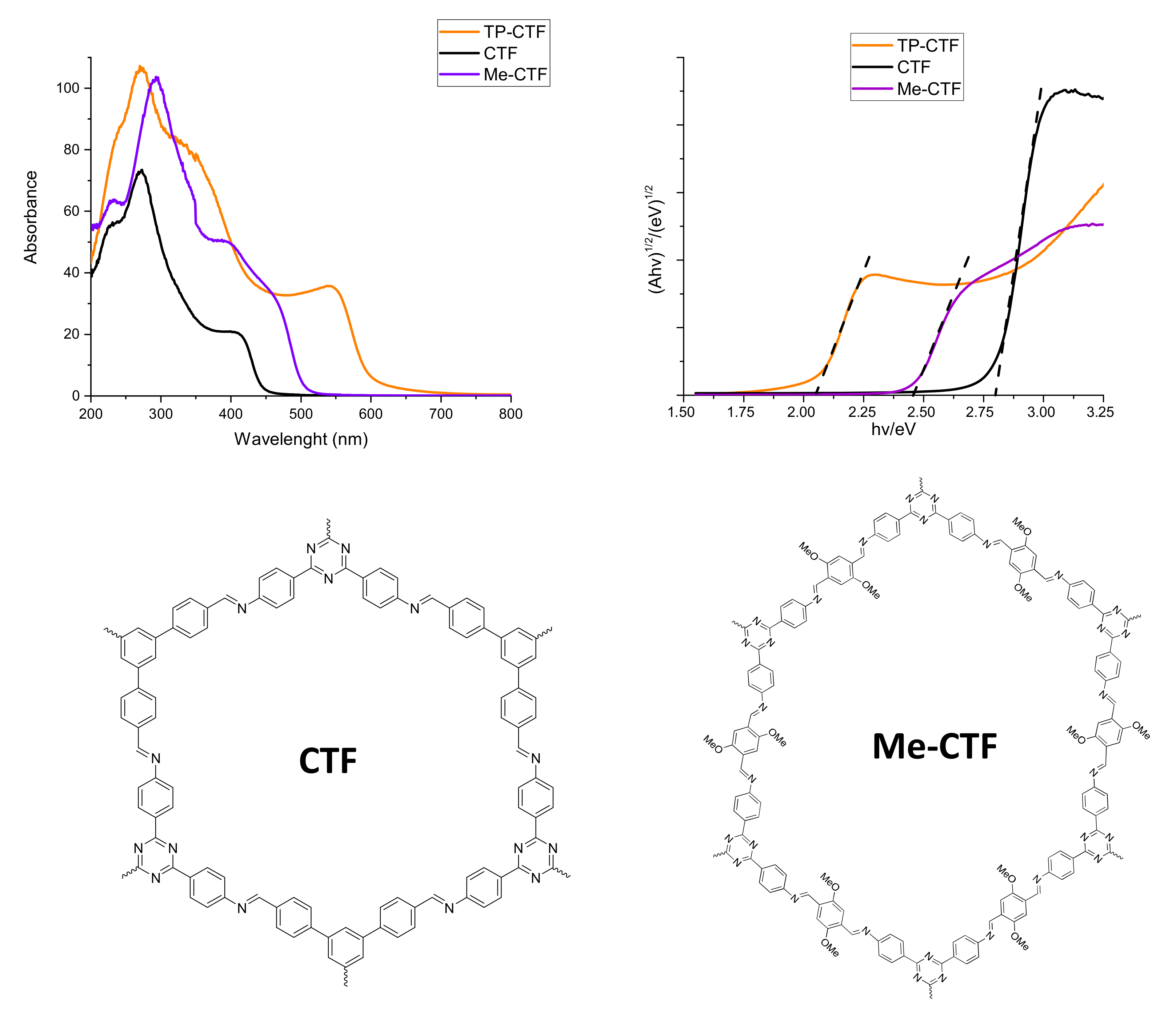
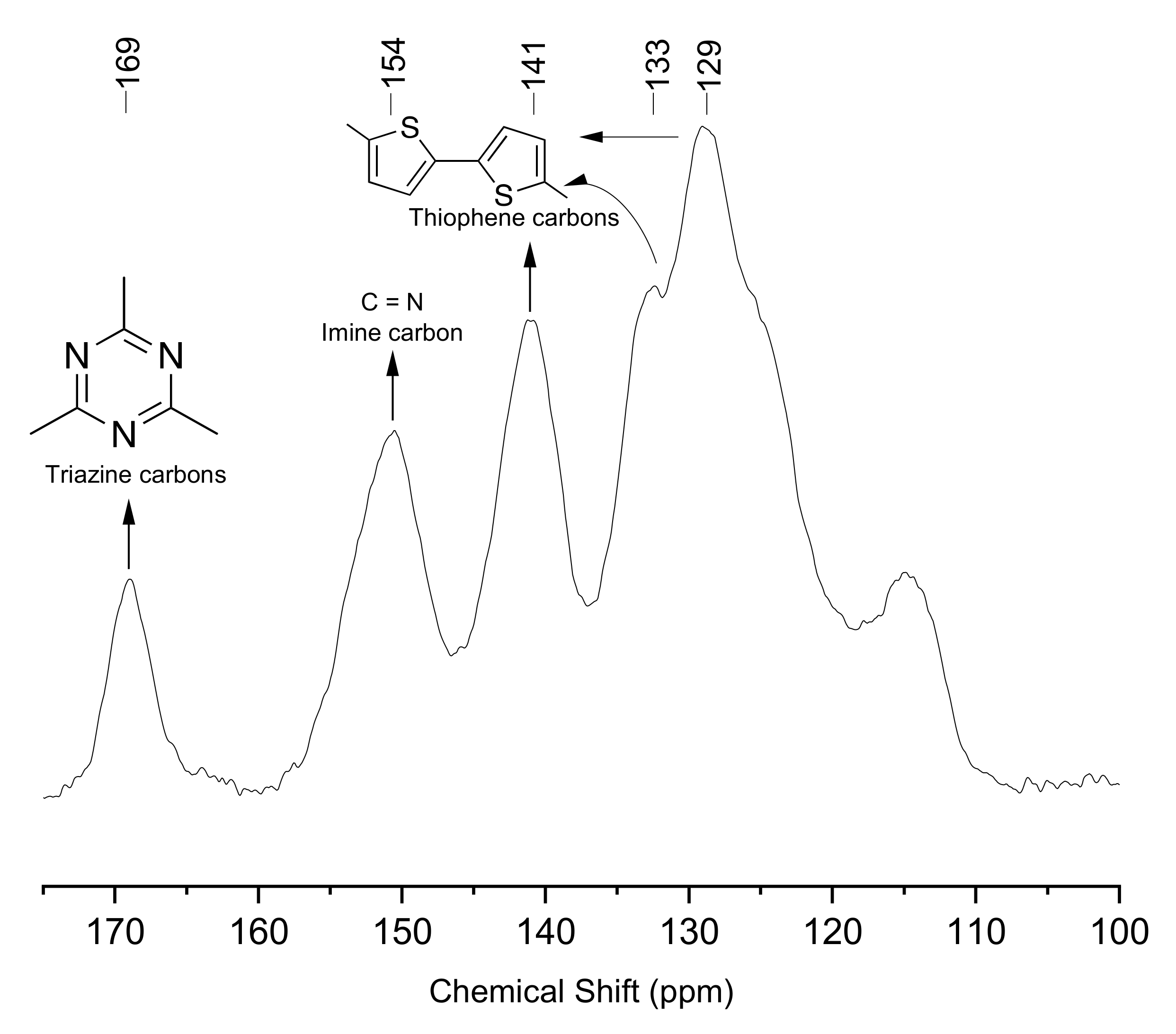

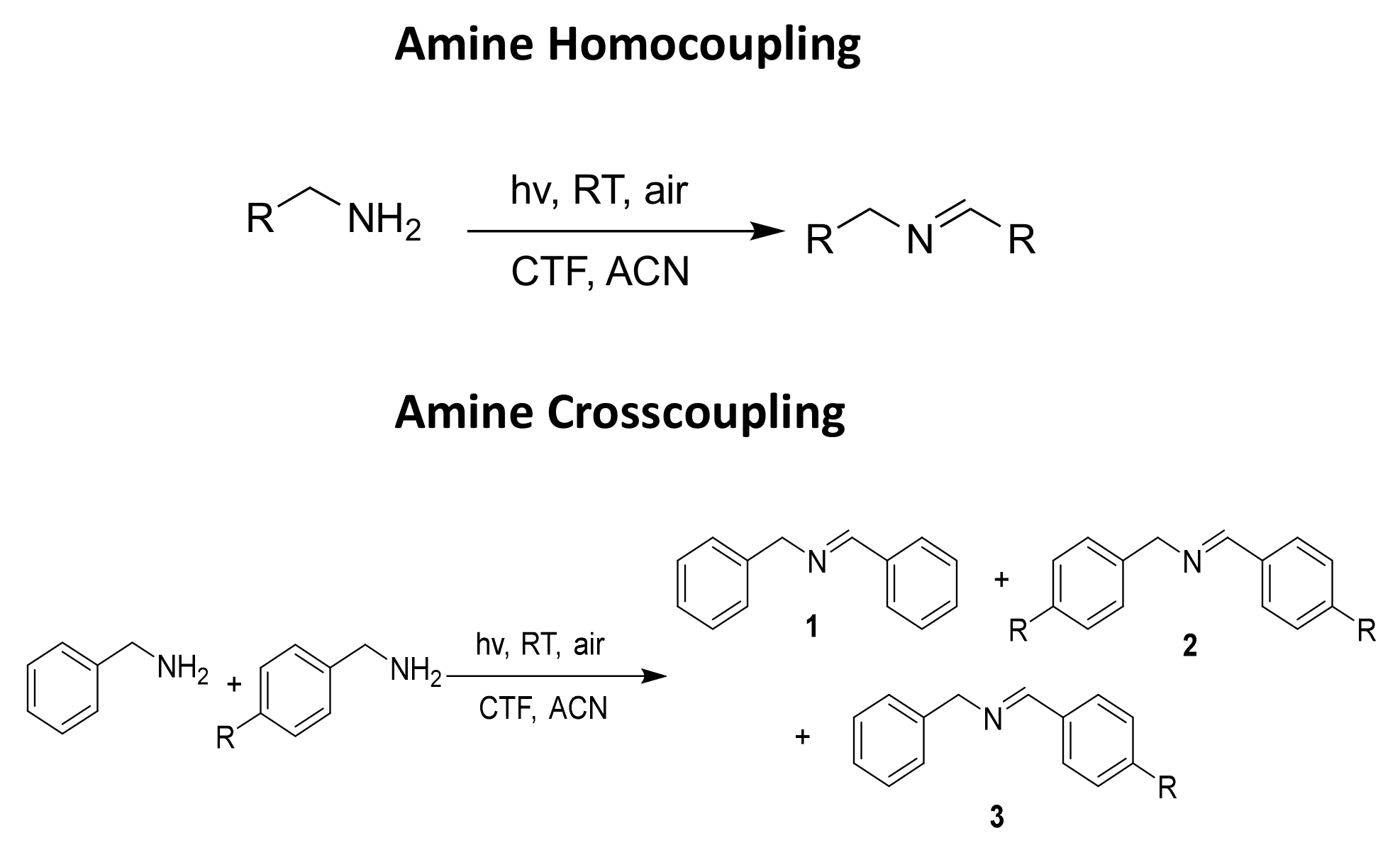
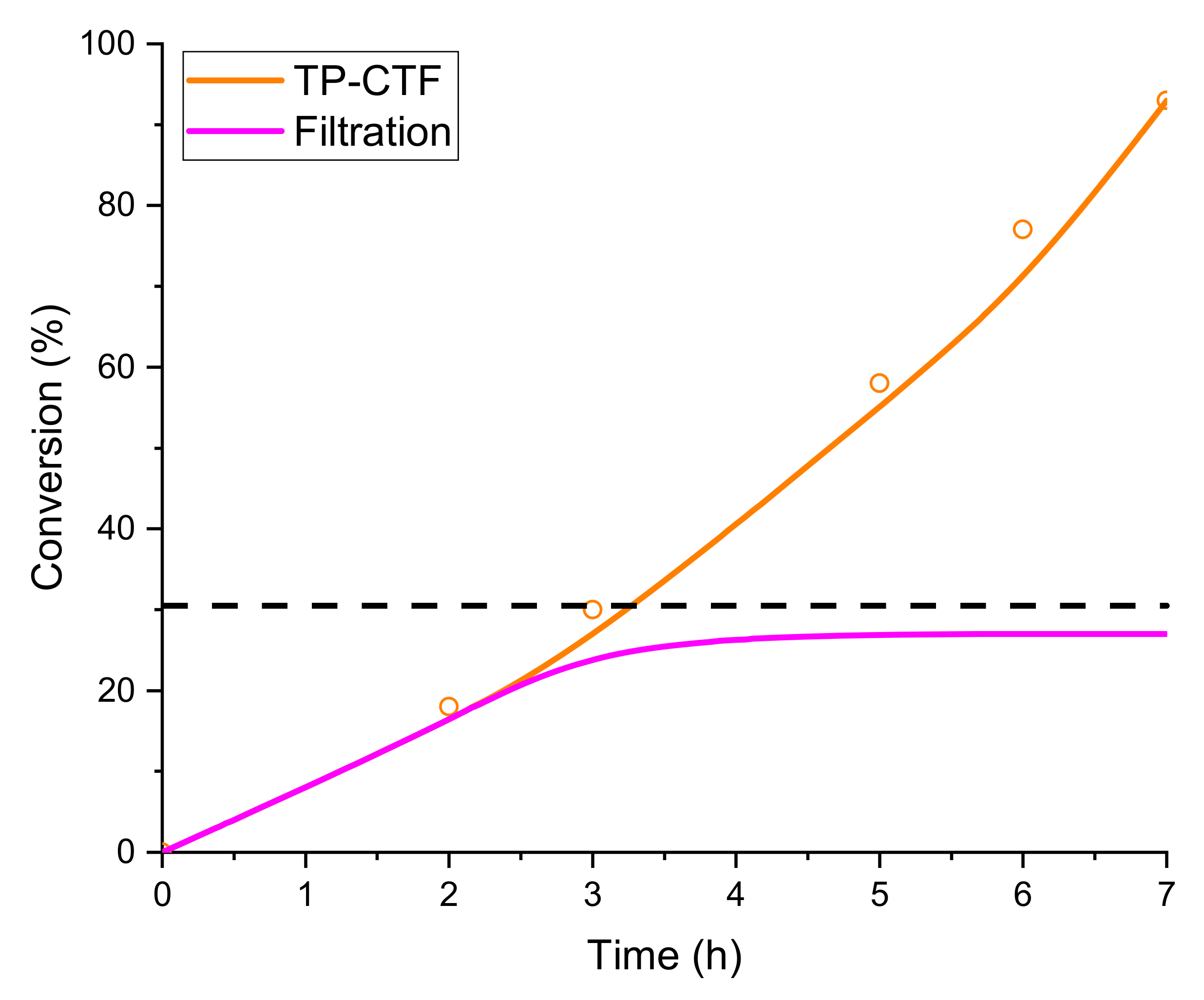
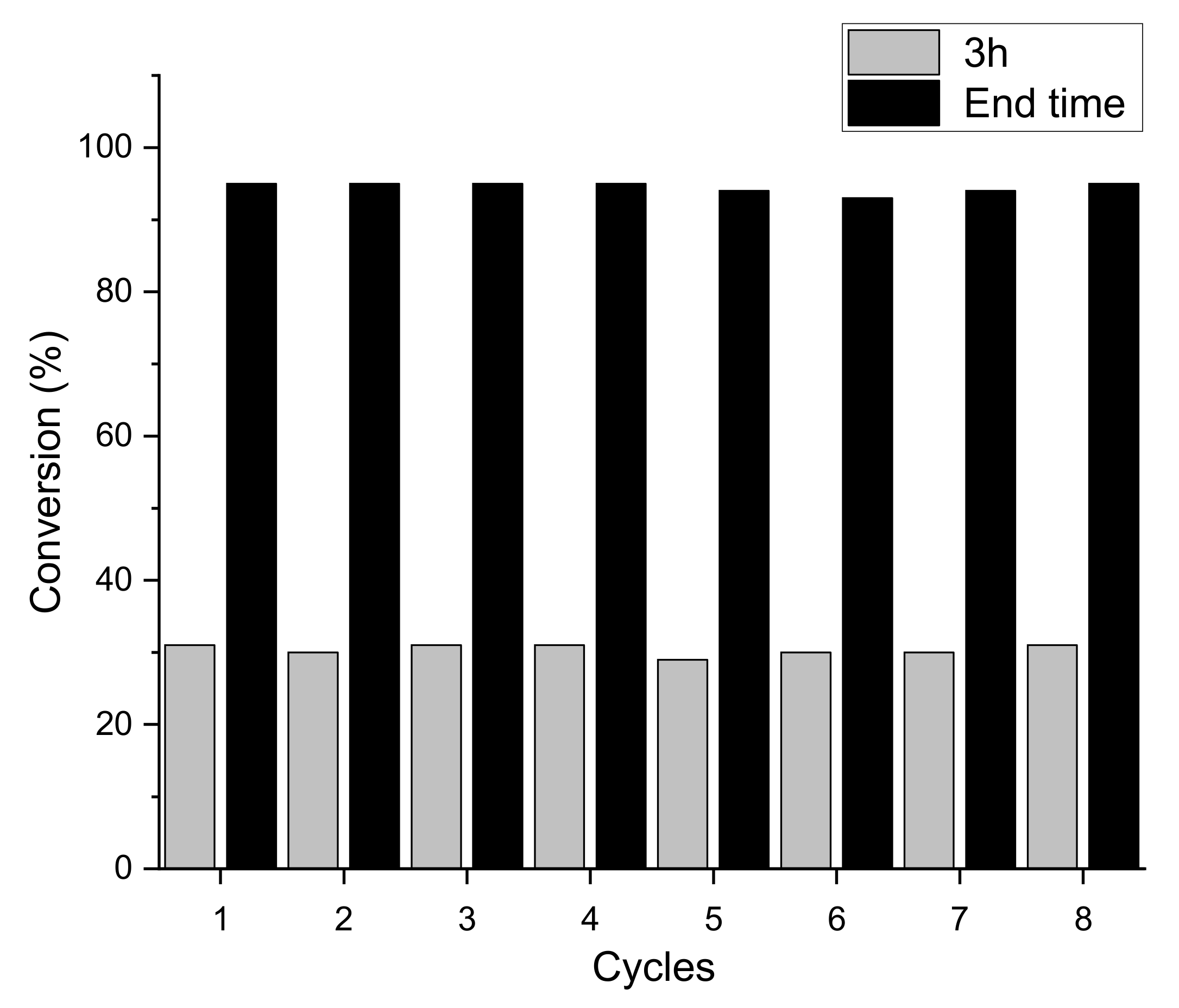
| Entry | Catalyst | Substrate | Product | Conv (%) | Select (%) |
|---|---|---|---|---|---|
| 1 | Blank |  |  | 0 | 0 |
| 2 | TP-CTF | 100 | 100 | ||
| 3 | TP-CTF b | 0 | 0 | ||
| 4 | CTF | 52 | 100 | ||
| 5 | Me-CTF | 30 | 100 | ||
| 6 | TP-CTF |  |  | 100 | 100 |
| 7 | TP-CTF |  |  | 100 | 100 |
| 8 | TP-CTF |   |  | 100 | 59 |
Disclaimer/Publisher’s Note: The statements, opinions and data contained in all publications are solely those of the individual author(s) and contributor(s) and not of MDPI and/or the editor(s). MDPI and/or the editor(s) disclaim responsibility for any injury to people or property resulting from any ideas, methods, instructions or products referred to in the content. |
© 2024 by the authors. Licensee MDPI, Basel, Switzerland. This article is an open access article distributed under the terms and conditions of the Creative Commons Attribution (CC BY) license (https://creativecommons.org/licenses/by/4.0/).
Share and Cite
Melero, M.; Díaz, U.; Llabrés i Xamena, F.X. Thiophene-Based Covalent Triazine Frameworks as Visible-Light-Driven Heterogeneous Photocatalysts for the Oxidative Coupling of Amines. Molecules 2024, 29, 1637. https://doi.org/10.3390/molecules29071637
Melero M, Díaz U, Llabrés i Xamena FX. Thiophene-Based Covalent Triazine Frameworks as Visible-Light-Driven Heterogeneous Photocatalysts for the Oxidative Coupling of Amines. Molecules. 2024; 29(7):1637. https://doi.org/10.3390/molecules29071637
Chicago/Turabian StyleMelero, Manuel, Urbano Díaz, and Francesc X. Llabrés i Xamena. 2024. "Thiophene-Based Covalent Triazine Frameworks as Visible-Light-Driven Heterogeneous Photocatalysts for the Oxidative Coupling of Amines" Molecules 29, no. 7: 1637. https://doi.org/10.3390/molecules29071637







